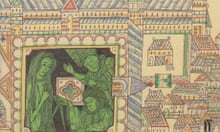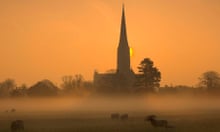Last week, I listed a few first thoughts about possible readings of The Spire. The discussion that followed showed that I hadn't even begun. As MythicalMagpie wrote:
"If ever a building could be said to be constructed entirely of metaphor and allegory, it must be Jocelin's spire."
queeqeg7 added:
"It can carry any number of readings and the characters are ambiguous enough [and real enough] to carry contradictions of their own."
Yep.
S/he added:
"I've tended to read Jocelin's folly as part of a profoundly human condition – the search for meaning, the construction of belief, even as exemplar of the novelist's ability to invent and elaborate. Nailing The Spire to Christianity works, but it limits or rather narrows our understanding of Art's capacity."
Inspired by queeqeg's handle, meltingman also pointed out that The Spire is "a poor man's Moby-Dick", a device for demonstrating what destroys the obsessed and those around them... That certainly rings true – although using the comparison to criticise seems unfair. What else is as good as Moby-Dick, after all? Besides, there is far more to The Spire than a retake on Melville, convincing as that reading may be.
Here are just a few of the possible interpretations that came up last week:
A symbol of hubris:
Dylanwolf says:
"The spire seems to me an enterprise equal in braggadocio and confusion to the construction of the Tower of Babel in the book of Genesis."
Meanwhile, jmschrei asks:
"How many completely inadequate people do we see promoted to positions beyond their ability in business, politics, the church? How much madness lies behind religious or creative vision? We have many great works of architecture, art or literature created by the efforts of individuals as driven and destructive as our poor dean. In that end what does this tell us about Golding's desire to make sense of his creative efforts in the context of his personal demons?
"The more I think about this brilliant novel the more it opens up questions. The ambiguity that I am sure has frustrated many a reader is, for me, the core of its power and strength as a work of literature."
A fertility symbol. (Kind of.)
everythingsperfect:
"The spire is also Goody Pangall, object of Jocelin's displaced sexual energy. But while the feared fertility sprouts in Goody, the spire remains pure and virginal."
An appletree
Dylanwolf again:
"Another metaphor for the spire that Golding proposes is Jocelin's late exclamation that 'It is like an appletree!'
"Interesting that again this presumably refers to the Tree of the Knowledge of Good and Evil that bore the forbidden fruit in the garden of Eden in Genesis. The 'apple' consumed by Eve introduced mankind to an inclination for evil. Other significant trees of the New Testament – the fig tree that Jesus curses or the sycamore that Zaccheus, the tax collector, climbs into are not within the scope of Jocelin's vision."
"Or perhaps Jocelin is referencing Psalm 1:3
"'He is like a tree planted by streams of water, which yields its fruit in season and whose leaf does not wither. Whatever he does prospers.'
"Jesus is rather more ambivalent in Matthew 7:15-17 we read
"'Watch out for false prophets. They come to you in sheep's clothing, but inwardly they are ferocious wolves. By their fruit you will recognise them. Do people pick grapes from thornbushes, or figs from thistles? Likewise every good tree bears good fruit, but a bad tree bears bad fruit.'"
A symbol of creation
JohnSelfsAslyum:
"One thing that struck me about The Spire is the sheer physicality and even violence of the writing. From the start, where the 'solid' light 'smashe[s]' through the windows, the sheer sensory force of Golding's style is almost overwhelming. Later, when a workman falls, 'the scream scored all the way down the air' and 'engraved' it. In that extraordinary (and again highly physical) sequence about a third into the book where the pit develops – what a set piece! – the sheet of metal they use to illuminate the lower depths causes the sunlight to be 'trapped and hurled straight down into the pit'.
"All this affirms the views expressed above that The Spire is, among other things, about the creation of something from nothing: buildings from empty space, gods from human needs, and books from thoughts. It's a fascinating, invigorating and challenging read."
A symbol of Golding's own struggle to write
rabburnout:
"Obviously a crudely simplistic 'Freudian' reading might see the spire as a symbol of both his writing – he aspired to create something of greatness, against some hostility, but worried that it was built on shaky foundations; and it is also a phallic symbol of course – again on shaky foundations."
Elsewhere in the discussion, the spire was also seen to symbolise Cold War fears, and even Golding's unhappy time in the navy. All valid readings. And that's just the spire itself. As Dylanwolf pointed out, we can also find plenty to think about in the rest of the building:
"The four pillars that support the spire might also be compared to the four gospels - they can bear the weight of the construction for a period but without the true foundation of Jesus Christ they are doomed to buckle and give way."
Clearly, this discussion could run and run - and I'll be glad to hear any other potential readings. But at this stage, I'm also developing a small worry. In talking so much about the "meaning" of the book, we aren't being entirely true to the process of reading it. As I turned the pages, potential interpretations were at the back of my mind – but quite a long way behind many other things. More pressing, for instance, was a desire to understand Jocelin, whether he was saint or sinner, genius or madman. The book too felt like a battle against God (or his non-existence), fate, the (presumably atheistic) laws of physics. And then, possibly even more importantly, there were the physical descriptions. The moving earth, the ladders, the growing building, the vertiginous heights:
"When a workman fell through the hole above the crossways, and left a scream scored all the way down the air which was so thick it seemed to keep the scream as something mercilessly engraved there, he did not wonder that no miracle interposed between the body and the logical slab of stone that received it."
More than the airy, intellectual book we have been describing, this The Spire is gutsy, primal, brutal. We should be able to provide an even longer list highlighting Golding's best evocations of solid stone, empty air and the claustrophobia they can cause. Over to you.





Comments (…)
Sign in or create your Guardian account to join the discussion